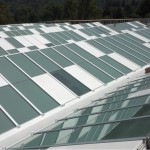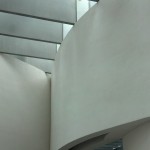The new North Wing will provide a superlative visitor experience in a state-of-the-art, “energy smart” building. Natural lighting and sophisticated temperature and air quality controls will provide the ideal interior environment for preserving the Museum’s unparalleled collection of contemporary art and design in glass. These elements also mean we are building an environmentally sensitive and architecturally distinctive structure.
One of the most prominent green features of the gallery building will be the use of natural daylight. Because we are a glass museum – and glass loves light – we have the unique opportunity to take advantage of this very green feature in a way that many museums cannot.
- Skylights allow daylight to light the galleries.
- Soft lighting,and bright white curved walls
Through the use of diffusing roof skylights, the majority of the lighting required to view the art will come from natural light. This allows power consumption levels, associated with the building lighting, to remain well under comparable gallery spaces in other museums. In addition to the natural daylight used to light the gallery, electric high efficiency fluorescent lighting is programmed to complement and spotlight the art by adjusting to changes in exterior natural light levels.
The building envelope has been carefully tuned both to protect the art and to contribute to the energy performance of the Museum. The majority of the windows and all of the skylights of the building are all double glazed insulated glass units. The glass also incorporates high performance low–E (low emissivity) coatings which help to keep the heat out during the summer and to keep the heat in during the winter; UV filtering coatings on the glass will also protect the art from damaging ultraviolet rays.
While glass can handle being in natural light, it must still be kept in a climate-controlled environment. The commissioning of the environmental controls systems by a third party is an important phase of construction. Third-party testing confirms all systems are running optimally and that the building is airtight. The building staff will also be fully trained on the operation and maintenance of the building systems for optimal environmental performance.
The landscaping also plays a role in environmental protection. At least half of the storm water from the roof and water from the loading dock area will drain into a landscaped bio-retention area, where the right plants and soil types allow the water to filter and percolate back into the soil. Less water is then needed to keep the plants alive.
Learn more about the Green Initiatives across the Museum campus.





2 comments » Write a comment